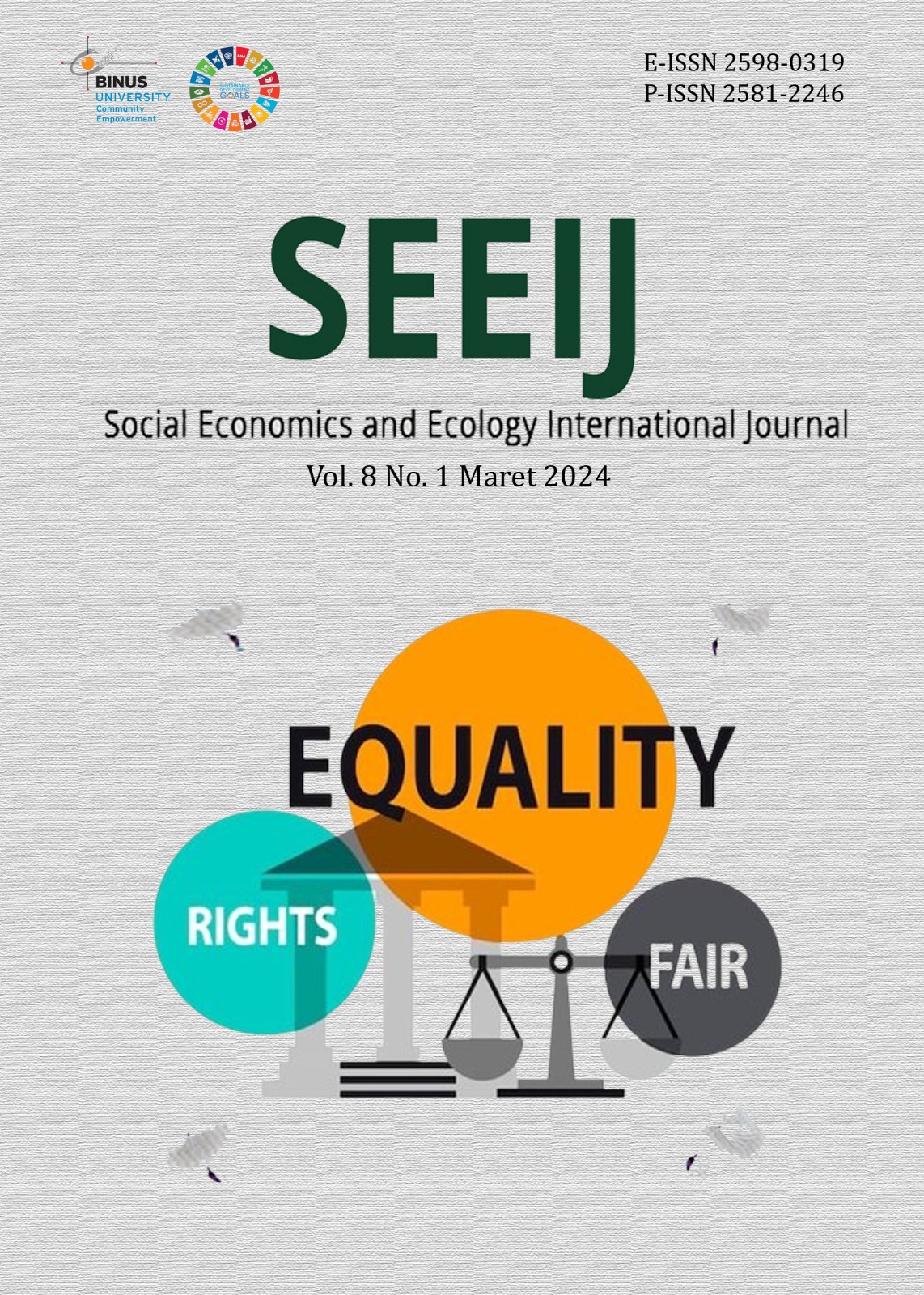MOTION GRAPHICS: AN ENTERTAINING AND ACCESSIBLE LEARNING MEDIA FOR THE STUDENTS
DOI:
https://doi.org/10.21512/seeij.v8i1.10911Keywords:
technology, video-based learning, motion graphics learningAbstract
In the Covid-19 pandemic, teachers and students must continue learning at home online. Online learning requires teachers to be more selective and creative in preparing teaching materials, including learning media. Learning media must be informative, contain all the material to be taught, and be interesting so students are interested in learning. One of the informative and interesting learning media that is currently widely used is video. Teachers must prepare videos that suit the material and students' abilities. Technology has been and is still being used on a large scale by teachers to assist teaching in the classroom. Both applications and products from these applications support the teaching and learning process and help students understand learning. One technological product currently widely used is video-based learning, and one type of VBL that can be used to create interesting learning media is Motion Graphic learning. MG is the process of designing, writing and moving images whose final product can be learning media. This Community Service Activity (PKM) is designed to educate teachers on the use of Motion Graphics as a learning medium for students. As a result, it is expected that this training will benefit teachers.
References
Alamarat, Y., & AlFakrah, A. (2020). Motion graphics morphology that effects customization engagement in graphic design. Journal of Critical Reviews, 7(19), 321–330. https://doi.org/10.31838/jcr.07.19.39
Almanfaluthi, B., & Juniar. (2020). Konsep Motion Graphics Pengenalan Layang-Layang Sebagai Budaya Bangsa. Jurnal Desain, 7(2), 99–109.
Amali, L. N., Zees, N., & Suhada, S. (2020). Motion Graphic Animation Video As Alternative Learning Media. Jambura Journal of Informatics, 2(1). https://doi.org/10.37905/jji.v2i1.4640
Branch, R. M. (2009). Instructional Design. In Encyclopedia of Evolutionary Psychological Science. Springer. https://doi.org/10.1007/978-3-319-19650-3_2438
Creswell, W. J., & Creswell, J. D. (2018). Research Design: Qualitative, Quantitative and Mixed Methods Approaches. In Journal of Chemical Information and Modeling (Vol. 53, Issue 9).
Dewi, K. C., Ciptayani, P. I., Surjono, H., & Priyanto. (2019). Blended Learning: Konsep dan Implementasi. In Alpha Beta, Bandung (Issue 28). Swasta Nulus.
Efendi, Y. A., Adi, E. P., & Sulthoni. (2020). Pengembangan Media Video Animasi Motion Graphics pada Mata Pelajaran IPA Di SDN Pandanrejo 1 Kabupaten Malang. JINOTEP (Jurnal Inovasi Dan Teknologi Pembelajaran): Kajian Dan Riset Dalam Teknologi Pembelajaran, 6(2), 97–102. https://doi.org/10.17977/um031v6i22020p097
Fatmawati, E., Karmin, & Sri Sulistiyawati, R. (2018). Pengaruh Media Pembelajaran Berbasis Video Terhadap Hasil Belajar Siswa Sejarah Artikel: Influence of Video-Based Learning Media to Student Learning Outcomes. Cakrawala Jurnal Pendidikan, 12(1), 24–31. http://e-journal.upstegal.ac.id/index.php/Cakrawala
Handoko, & Waskito. (2018). Blended Learning: Konsep dan Penerapannya. In Blended Learning: Konsep dan Penerapannya (Issue April). Lembaga Pengembangan Teknologi Informasi dan Komunikasi (LPTIK) Universitas Andalas. https://doi.org/10.25077/car.64.60
Hapsari, A. S., Hanif, M., Gunarhadi, & Roemintoyo. (2019). Motion graphic animation videos to improve the learning outcomes of elementary school students. European Journal of Educational Research, 8(4), 1245–1255. https://doi.org/10.12973/eu-jer.8.4.1245
Mitrovic, A., Dimitrova, V., Lau, L., Weerasinghe, A., & Mathews, M. (2017). Supporting constructive video-based learning: Requirements elicitation from exploratory studies. Lecture Notes in Computer Science (Including Subseries Lecture Notes in Artificial Intelligence and Lecture Notes in Bioinformatics), 10331 LNAI, 224–237. https://doi.org/10.1007/978-3-319-61425-0_19
Nasution, N., Jalinus, N., & Syahril. (2019). Buku Model Blended Learning (1st ed.). Unilak Press.
Perdani, Y. D. (2022). Enhancing the Students’ Grammar Comprehension by Utilizing the Video-based Instruction. In ACM International Conference Proceeding Series (Vol. 1, Issue 1). Association for Computing Machinery. https://doi.org/10.1145/3572549.3572600
Prabowo, R. W. E. (2020). Perancangan Motion Graphic Iklan Layanan Masyarakat “Waspada Terhadap Cybercrime.†DeKaVe, 1(1), 57–63. https://doi.org/10.24821/dkv.v1i1.3871
Romadonah, Eden Siti, & Maharani, I. N. (2019). Motion Graphic Sebagai Media Pembelajaran. Utile Jurnal Kependidikan, V(Nomor 2), 115–122.
Sagala, Siti Haminah. Ivan Nugraha., dan R. S. (2020). Pembuatan Motion Graphics SOP Produksi Berita sebagai Media Promosi di PT Bintang Advis Multimedia. Indonesian Journal of Science, 1(3), 152–161.
Saputra, R. D., & Wibawa, S. C. (n.d.). Studi literatur pengembangan motion graphic video studi literatur pengembangan motion graphic video sebagai tren media pembelajaran untuk meningkatkan hasil belajar rizky dias saputra pendidikan teknologi informasi , fakultas teknik , universitas negeri.
Simanjuntak, R. A., & Deli. (2020). Studi Penerapan Animasi Dan Motion Graphic Dalam Meningkatkan Kualitas Iklan Digital. Conference on Business, Social Sciences and Innovation Technology, 1.
Sukmanasa, E., Novita, L., & Majid, R. A. (2019). Use of Learning Video Media on Human and Environmental Subthema. Jhss (Journal of Humanities and Social Studies), 3(2), 72–75. https://doi.org/10.33751/jhss.v3i2.1459
Wiana, W., Syaom Barliana, M., & Riyanto, A. A. (2018). The effectiveness of using interactive multimedia based on motion graphic in concept mastering enhancement and fashion designing skill in digital format. International Journal of Emerging Technologies in Learning, 13(2), 4–20. https://doi.org/10.3991/ijet.v13i02.7830
Yahya, S. (2019). Interactive Motion Graphic of puppet beber pacitan in social media basis on video. XI(2).
Downloads
Published
How to Cite
Issue
Section
License
Copyright (c) 2024 Yella Dezas Perdani

This work is licensed under a Creative Commons Attribution-NonCommercial 4.0 International License.
The Authors submitting a manuscript do so on the understanding that if accepted for publication, copyright of the article shall be assigned to SEEIJ Community Development Academic (CDA) Bina Nusantara University as publisher of the journal.
Copyright encompasses exclusive rights to reproduce and deliver the article in all form and media, including reprints, photographs, microfilms and any other similar reproductions, as well as translations. The reproduction of any part of this journal, its storage in databases and its transmission by any form or media, such as electronic, electrostatic and mechanical copies, photocopies, recordings, magnetic media, etc., will be allowed only with a written permission from SEEIJ Community Development Academic (CDA) Bina Nusantara University.
SEEIJ Community Development Academic (CDA) Bina Nusantara University, the Editors and the reviewer make every effort to ensure that no wrong or misleading data, opinions or statements be published in the journal. In any way, the contents of the articles and advertisements published in the SEEIJ are sole and exclusive responsibility of their respective authors and advertisers.

This work is licensed under a Creative Commons Attribution-NonCommercial 4.0 International License.









